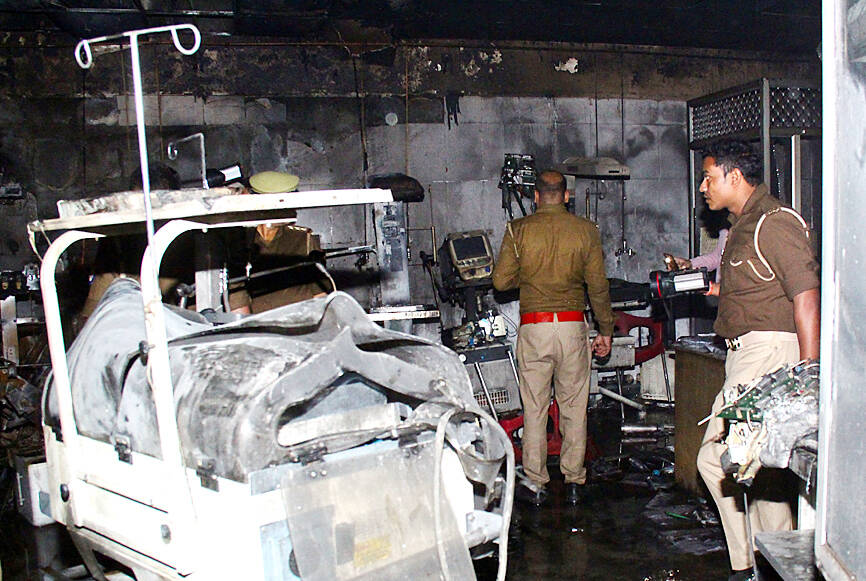A fire at the neonatal unit of an Indian hospital killed 10 newborns, authorities said yesterday, with another 16 clinging to life after a blaze blamed on a faulty oxygen machine.
The fire, which broke out at about 10:30pm on Friday night at the Maharani Lakshmibai Medical College in Jhansi, spread quickly through the ward, where 55 infants were being treated.
Forty-five babies were rescued and are receiving medical care, local official Bimal Kumar Dubey said.

Photo: Reuters
Footage from the scene showed charred beds and walls inside the ward as a crowd of anguished families waited outside.
“My child has gone forever,” one mother wailed as she clutched her head in grief.
Babies rescued from the fire, all only days old, were laid side by side on a bed elsewhere in the hospital as hospital staff hooked up their arms to intravenous drips.
“Ten infants have sadly died,” Uttar Pradesh Deputy Chief Minister Brajesh Pathak told reporters. “Seven bodies have been identified. Three bodies haven’t been identified as yet.”
Another 16 infants who were rescued were undergoing medical treatment, police superintendent Gyanendra Kumar Singh said.
The fire likely started in a piece of machinery used to enrich the level of oxygen in the atmosphere, he said.
“All children rescued are safe and getting medical attention,” Singh said. “The fire was most likely due to a fire in an oxygen concentrator.”
Pathak, who visited the hospital and met with families, pledged government support for the victims’ families and promised a thorough investigation.
“The cause of the fire will be probed,” he said. “If any lapses are found, strict action will be taken against those responsible and no one will be spared.”
A safety audit of the hospital was carried out in February followed by a fire drill three months later, he said.
When the firefighters arrived, the ward was engulfed in flames and plumes of smoke. Rescuers had to break through windows to reach the newborn babies.
Eyewitnesses said the rescue operation began about 30 minutes after the fire erupted, delaying evacuation efforts.
The accident has raised questions over the hospital’s safety measures. While fire alarms had been installed in the intensive care unit, parents and witnesses said they did not activate during the blaze. Hospital staff acted only after they saw signs of smoke and fire.
“If the safety alarm had worked, we could have acted sooner and saved more lives,” said Naresh Kumar, a parent who lost his baby.
Akhtar Hussain, whose son was rescued and is receiving treatment in an adjacent ward, agreed that the tragedy could have been prevented if the hospital had better safety protocols.
Friday’s fire comes six months after a similar blaze at a children’s hospital in New Delhi that killed six newborns. Authorities said that hospital was not properly licensed and lacked proper fire exits, and police arrested a doctor and the facility’s owner in the aftermath.
The May blaze occurred just hours after least 27 people were killed, including several children, when a fire broke out at a packed amusement park arcade in another part of the country.

Kehinde Sanni spends his days smoothing out dents and repainting scratched bumpers in a modest autobody shop in Lagos. He has never left Nigeria, yet he speaks glowingly of Burkina Faso military leader Ibrahim Traore. “Nigeria needs someone like Ibrahim Traore of Burkina Faso. He is doing well for his country,” Sanni said. His admiration is shaped by a steady stream of viral videos, memes and social media posts — many misleading or outright false — portraying Traore as a fearless reformer who defied Western powers and reclaimed his country’s dignity. The Burkinabe strongman swept into power following a coup in September 2022

‘FRAGMENTING’: British politics have for a long time been dominated by the Labor Party and the Tories, but polls suggest that Reform now poses a significant challenge Hard-right upstarts Reform UK snatched a parliamentary seat from British Prime Minister Keir Starmer’s Labor Party yesterday in local elections that dealt a blow to the UK’s two establishment parties. Reform, led by anti-immigrant firebrand Nigel Farage, won the by-election in Runcorn and Helsby in northwest England by just six votes, as it picked up gains in other localities, including one mayoralty. The group’s strong showing continues momentum it built up at last year’s general election and appears to confirm a trend that the UK is entering an era of multi-party politics. “For the movement, for the party it’s a very, very big

ENTERTAINMENT: Rio officials have a history of organizing massive concerts on Copacabana Beach, with Madonna’s show drawing about 1.6 million fans last year Lady Gaga on Saturday night gave a free concert in front of 2 million fans who poured onto Copacabana Beach in Rio de Janeiro for the biggest show of her career. “Tonight, we’re making history... Thank you for making history with me,” Lady Gaga told a screaming crowd. The Mother Monster, as she is known, started the show at about 10:10pm local time with her 2011 song Bloody Mary. Cries of joy rose from the tightly packed fans who sang and danced shoulder-to-shoulder on the vast stretch of sand. Concert organizers said 2.1 million people attended the show. Lady Gaga

SUPPORT: The Australian prime minister promised to back Kyiv against Russia’s invasion, saying: ‘That’s my government’s position. It was yesterday. It still is’ Left-leaning Australian Prime Minister Anthony Albanese yesterday basked in his landslide election win, promising a “disciplined, orderly” government to confront cost-of-living pain and tariff turmoil. People clapped as the 62-year-old and his fiancee, Jodie Haydon, who visited his old inner Sydney haunt, Cafe Italia, surrounded by a crowd of jostling photographers and journalists. Albanese’s Labor Party is on course to win at least 83 seats in the 150-member parliament, partial results showed. Opposition leader Peter Dutton’s conservative Liberal-National coalition had just 38 seats, and other parties 12. Another 17 seats were still in doubt. “We will be a disciplined, orderly